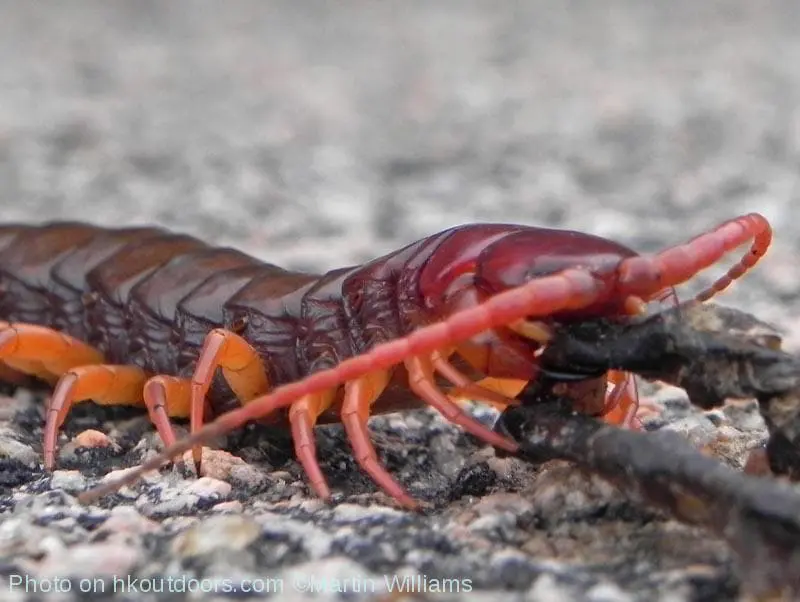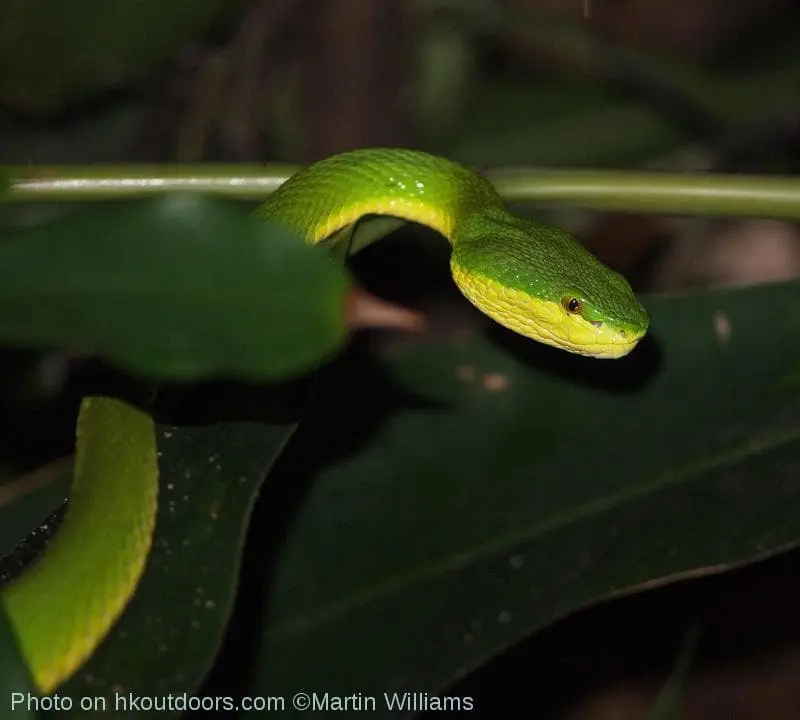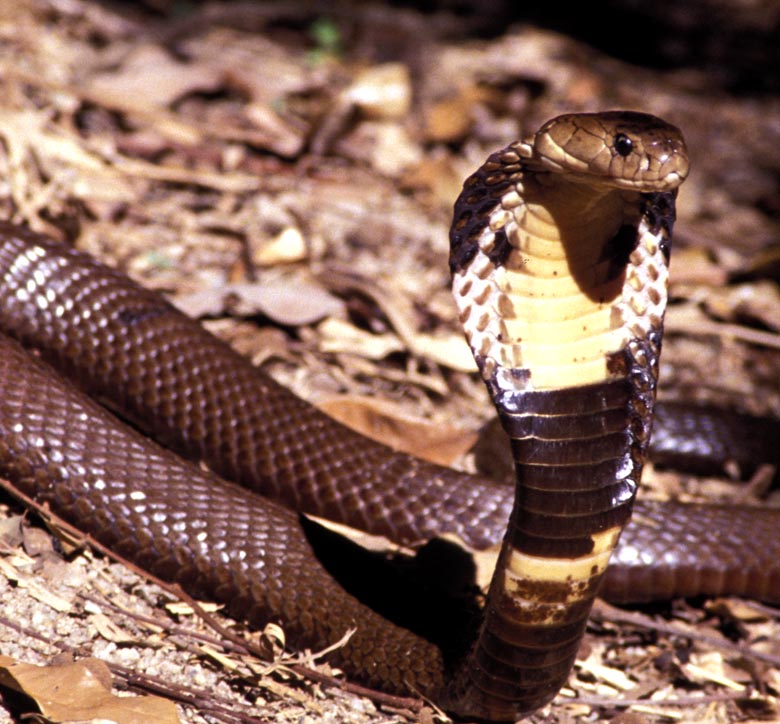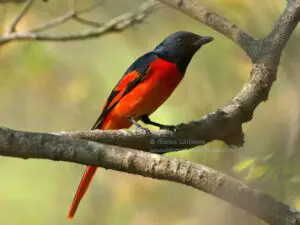A quick look at animals with venom, killer teeth and blades.
Giant Centipede

Growing to perhaps 8 inches long, running fast, and almost alien in appearance, Giant Centipede is perhaps the ultimate in creepy-crawlies. Its front legs have involved into sharp fangs that can inject venom for killing prey animals.
Centipede bites are fairly common in rural parts of Hong Kong; I’ve been bitten perhaps three times on Cheung Chau, where I live – twice heading to hospital for anti-histamines to reduce inflammation, as seems I’m allergic to the venom.
But though they can be painful, and sometimes send people to hospital for treatment, such bites are rarely fatal (worldwide: Wikipedia entry on Scolopendra, the family of giant centipedes) – though I have heard somewhere that a bite could kill a baby.
So, while a fabulous member of the list in terms of being scary, this is by no means Hong Kong’s Number One Deadliest Anima.
Blue-ringed Octopus
Blue-ringed Octopuses are small, and usually well camouflaged – yet if disturbed, they become patterned with blue circles, which are intended as a warning yet can make them appear attractive to people, especially children. They can bite in self defence, and though the bite may be painless, its effects can prove lethal.
The venom includes tetrodotoxin, a neurotoxin that’s 10,000 times more toxic than cyanide (Wikipedia entry on Blue-ringed Octopus). This can cause paralysis, making artificial respiration necessary to prevent death – and respiration is required even if someone bitten appears moribund, since it’s possible to be conscious and yet appear dead from the effects of a Blue-ringed Octopus bite.
So far, so scary. Yet I haven’t heard of anyone being bitten by a Blue-ringed Octopus in Hong Kong; seems they are mainly encountered by divers, who treat them with care.
Bamboo Snake

Bamboo Snakes are vipers, fairly common here, and mainly active at night. Venomous, prone to sit tight as people approach, and striking readily if threatened, they are threatening. Yet the bite is rarely fatal to humans; I read a newspaper report from some years ago of a young girl dying of a Bamboo Snake bite on Cheung Chau.
Domestic Dogs

I recall a newspaper report of a child being killed by domestic dogs – after mistakenly entering their backyard in a Hong Kong village. Can’t find this by quick googling, but found an item on Baby boy savaged by pack of stray dogs in Hong Kong:
The boy’s mother rushed out of their village home in Yuen Long near Hong Kong’s border with China when she heard her son screaming, and chased the dogs away with the help of a passer-by.
Dog catchers were later sent out to try to trap the mongrel dogs, which are thought to have attacked other children and villagers in the area in recent weeks.
Hong Kong is home to more than 25,000 stray dogs. Many are used as unofficial guard dogs on constructions sites, then abandoned when building works are finished.
The dogs involved in the Yuen Long attack are believed to have been left to run wild after being used as guard dogs at a container truck parking area that closed last year.
There are some packs of feral dogs in wild areas of Hong Kong – all unfortunate animals dumped by former owners, or their offspring. They’re sometimes rounded up, which typically means they are then put to death; often, they’re nervous of people, running away fast. Sadly, too few people think before getting a pet, and Hong Kong’s problem with strays, some of which might be dangerous, continues.
Stray dogs just might carry rabies, too; yet this is not endemic in Hong Kong, and if any is found there are quick operations to stamp it out.
Rats with Fleas with Plague
Today, rats are mainly potential problems for carrying and spreading diseases associated with poor sanitation.
Yet in the past, they likely helped spread bubonic plage, which particularly affected Hong Kong from 1894, killing 20,489 people in a 30-year epidemic (which also led to the discovery of the bacillus causing plague.
So, indirectly, rats have been historically deadly to humans in Hong Kong, but today are mainly pests.
Chickens with Bird Flu
H5N1 bird flu was first found to infect humans in Hong Kong in 1997, when 18 people were found to be affected, six of whom died. The source was chickens in poultry farms, and massive poultry culls were implemented. In 2003, there were more cases in Hong Kong, with a man dying, probably after catching bird flu from poultry in China: Bird flu claims Hong Kong victim.
Though highly pathogenic bird flus are strongly associated with industrial farming (Farms, wild birds and biosecurity re flu esp H5N1), even backyard poultry keeping has been banned in Hong Kong, and there has been fearmongering regarding wild birds, never mind they are victims not vectors of H5N1.
Hence, the scariness of birds – including chickens – has been wildly exaggerated.
Mosquitoes with Diseases
Malaria was historically a msjor killer in Hong Kong, including when the Britsh army set up camp in the area now known as Happy Valley. Happily, it has been locally extirpated; yet the potential threat leads to ongoing mosquito reduction programmes.
In recent years, there have been occasional incidents involving dengue fever, though they tend to involve people infected overseas, and – fortunately – this disease has not become locally established, partly because Hong Kong does not have the optimum mosquito species for carrying it.
Another potentially fatal mosquito-borne disease, Japanese encephalitis, may be present here, especially in mosquitoes frequenting some small marshes, but is rare.
Cobras

Hong Kong has snakes packing far more potent venom than Bamboo Snakes, including Chinese Cobra and KIng Cobra, which at up to 5.5 metres is the world’s longest venomous snake. The former is fairly common, the King Cobra scarce. Happily, both tend to move out of the way of people if they have the chance; unless, that is, a female King Cobra happens to be defending her nest – in which case, she migh rear up, hood outstreched, to warn off anyone who might approach (good job they aren’t common, and perhaps nest away from paths!)
I’ve read of a couple of King Cobra bites leading to deaths in Hong kong; both perhaps involved snake catchers, one of whom reportedly had a cup of Chinese tea as he awaited his fate.
Sharks

In the early 1990s, there was a flurry of shark attacks and probable shark attacks in eastern Hong Kong waters, leading to ten fatalities or people going missing, probably as a result of attacks by one or more large sharks: The Sai Kung Shark Attacks – early 90′s, Sai Kung.
There was considerable media hooplah, including Australian shark hunter Vic Hislop arriving to find and kill the responsible shark, with no success. The incidents led to the government installing shark nets at all gazetted beaches.
Since 1995, there hasn’t been a reported shark attack in Hong Kong, Indeed, I haven’t seen a report of a sizable shark that could attack humans, as sharks are rare here now thanks to massive over-fishing: Hong Kong Sharks.
… which brings us to Hong Kong’s Number One Deadliest Animal …
… drum roll please …
…
Homo sapiens
Yes, humans must take top spot as Hong Kong’s Deadliest Animal.
Whether chopping strangers or family members, crashing vehicles, polluting air and innumerable other actions, humans deliberately and accidentally kill far more humans each year than all the above animals combined.
Plus, of course, humans cause carnage in the natural world; we’ve chopped down Hong Kong’s original forest cover, exterminated a host of creatures – some deadly (tigers, crocodiles), many not – that used to live here, and we continue over-fishing and over-concreting, as well as changing climates.
And yet, we can also be compassionate, saving lives of humans and other species, working to conserve and nurture ecosystems. Go figure!






























Shark
Sharks are everywhere, there not just there.
Are they all native to Hong Kong
are they all native to Hong Kong
Mostly native
Well, mostly native
Chickens w bird flu: something from humans, from farming
Humans: originated in Africa, though spread here naturally